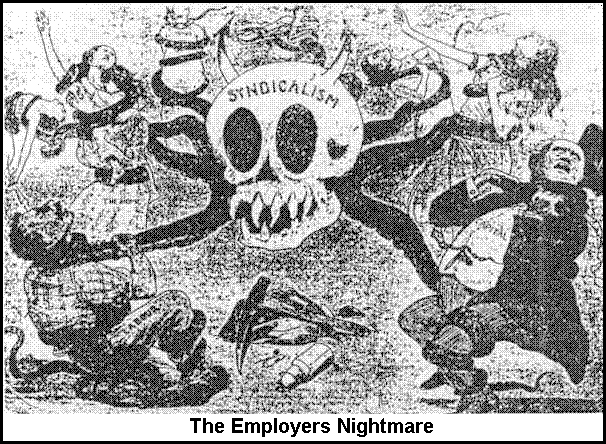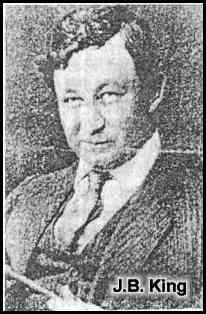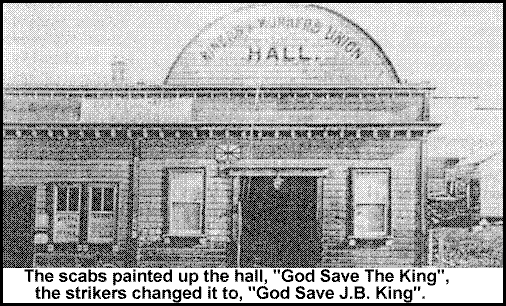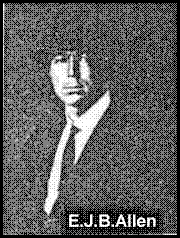Todays trade and industrial unions date from around the turn of the century, and some go back much earlier. Many, especially the unskilled unions, were very militant. They quickly absorbed the ideas of Industrial Unionism and Syndicalism that were sweeping the world. 'Re word Syndicalism comes from the French, meaning union, but in English speaking countries it is generally considered to mean revolutionary unionism. Although there are differences between Industrial Unionism and Syndicalism the terms are for all practical purposes interchangeable. Industrial Unionism wasn't new to this country and has its origins in South Canterbury, with the formation of the shearers unions in the 1880's. It made sense for seasonal workers to combine in terms of industry instead of craft. Many workers would move from shearing and other pastoral work to the meat, dairy, and flax industries or perhaps onto the wharves, or into the mines. So it made sense to form the "One Big Union" on the job instead of remaining divided into several craft unions. The travelling union card. Pat Hickey, one of the leaders of the Red Federation of Labour, maintains in his memoirs that members of the Federation never thought of themselves as miners or watersiders but as "Federationists", and as members of the working class.
The basic ideas of Syndicalism are; direct action in the work place and community; a decentralised union structure with no paid full time officials; all decisions made at a general assembly of workers; and recallable delegates assigned to carry out the decisions of the assembly. Syndicalists generally feel that political parties are a divisive influence within the workers movement. They reject ballot box politics for direct action and consider the general strike to be the most powerful weapon working people have against the employers and the state. But it wasn't enough to fight for better wages and conditions. The industrial unions were seen as the building blocks for a future co-operative society. They were the training ground for a better future.
The story of the I.W.W. in Aotearoa cannot be told without considering the wider labour movement. The Wobblies weren't a small sectarian group isolated from the tumultuous events of those times. Often they were at the centre, and the leading spirit within the militant workers movement. At no other time did the ideas of anarcho-syndicalism have such a wide popular appeal. After the defeat of the 1891 Maritime Council, the workers movement in New Zealand went into decline. Depression years followed. In 1894 the Liberals introduced the Industrial Conciliation, and Arbitration Act, and we've had it in various forms ever since, until recently. The I.C.A. Act did encourage the formation of unions but it also curtailed the right to strike, and tended to divide the union movement. However by 1905 working people were again becoming restless. 1905 also saw the formation of the Industrial Workers of the World in the United States. The ideas of the Wobblies, as they were called, began to filter through to New Zealand. There was now a new air of militancy especially amongst the miners. Between 1900 and 1911 the workforce in the mines increased by nearly 75%. With this increase also came the atrocious working and living conditions, intransigent employers and of-course mine disasters. The miners, wharfies, shearers and labourers were the backbone of the new movement. Many militants from Europe and America toured New Zealand and Australia advocating Industrial Unionism. The newly formed Socialist Party organised many of these tours and began publishing articles on Industrial Unionism in it's paper, the "Commonweal".
In 1907 Ben Tillet, of the London Dockers, toured New Zealand preaching revolutionary Industrial Unionism. Pat Hickey was one of the organisers of the tour on the West Coast. Hickey had spent some time in England and Ireland. He worked in the U.S.A. and was a member of the Western Federation of Miners. The miners were the driving force behind the I.W.W. but left shortly after it was formed. It is important to point out that up until 1908 the American I.W.W. had two distinct factions; those who supported both revolutionary political action and organisation at the point of production, and those that repudiated politics for direct action on the job. There was a split in 1908 and the supporters of politics and Daniel De Leon formed the Detroit I.W.W. The majority became what was known as the Chicago I.W.W., the anti political union. In New Zealand up until 1911 the labour movement generally supported both revolutionary politics and Industrial Unionism, but by 1911 the movement split into two groups; the militants advocating direct action in the workplace, and the others ballot box politics.
In 1907 H.M. Fitzgerald arrived in Aotearoa from Canada. He became a Socialist Party organiser and toured the West Coast in 1908. He was a revolutionary socialist and syndicalist. Before his tour he established a branch of the I.W.W. in Wellington. One hundred workers attended the first meeting. But the most significant event of 1908, besides the famous strike in Blackball, was the formation of the first Federation of Labour, the "Red Federation". The Federation was strongly influenced by the ideas of the I.W.W. and Syndicalism. However it was a mixture of the old conservative craft unions, and industrial unions. The leadership of the federation played a difficult juggling act between revolutionary politics on the one hand and syndicalism on the other. The Federation was mostly made up of miners unions to start with and growth was slow. The first test of the Federations strength came in late 1908 when a new workers compensation act provided for employers liability for occupational diseases such as miners consumption. The mining companies demanded that the men undergo a medical examination before being re-employed after Christmas. The Federation threatened strike action, the government intervened and ordered the State Insurance Department to issue policies without prior examination.
Events in Australia had a profound influence on New Zealand labour. There was a constant flow of workers between the two countries and the west coast of America. During 1909-1910 strikes by miners in Newcastle and Broken Hill, converted the majority of miners in this country to Industrial Unionism. Late 1909 saw the arrival of Harry Scott Bennett from Australia. He had been active in the Victorian Socialist League and the Labour Party, whom he represented in the Victorian Parliament in 1904. He lost his seat in 1907. He was briefly a member of the Australian I.W.W. in 1908, but however he resigned in September of the same year. Bennett was first employed by the Federation, then the Socialist Party in Auckland. He toured the West Coast, and then Auckland province. In February 1910 he visited Christchurch, where he received an enthusiastic response, especially from the General Labourers Union. The Labourers Union had been growing rapidly since 1908. The leadership supported the Labour Party, but an increasingly militant rank and file supported the Federation and industrial unionism. By January 1911 an Industrial Unionist Club was established by the militants who organised open air meetings and sold pamphlets. A branch of the I.W.W. was also formed and S.J.Roscoe, a shearer, was one of its leading members. The I.W.W. group applied for membership of the Federation and was admitted in June 1911. But it wasn't until January 1912, after a long and protracted battle with the conservative leadership of the General Labourers Union that the labourers finally voted to join the Federation. After his South Island tour, Bennett returned to Auckland where he worked on the Socialist Party's paper the "Leader". The Socialist Party was extremely active during this period. In February 1911, Bennett established a weekly paper the "Social Democrat". The "Leader" had to close because of a libel case.

The Federation of Labour continued to increase it's membership. In February 1912 there were forty three affiliated unions with a total membership of fifteen thousand. Miners, shearers, and watersiders made up ten thousand members. However the anti political socialists began criticising the leadership for its inaction, and apparent willingness to accommodate political action. The conflict was particularly intense in Auckland. Throughout 1911 and into 1912 a series of industrial disputes developed. The most important involved council labourers affiliated to the Auckland General Labourers Union. Six hundred labourers went on strike over working conditions. The council capitulated but it was only a partial victory. Early in 1912 the employers refused to recognise the union and agree to an "award". The union placed the matter in the hands of the Federation who did nothing. By February the union was de-registered, even though they had left the arbitration system. The dispute dragged on, and by March the council and employers had formed a scab union which was gaining members. The dispute collapsed out of inaction by the Federation. Their answer was to organise an alternative candidate to Parr, the mayor who smashed the labourers in the forthcoming council elections. The electoral results were disastrous for the Labour candidate. From then on the "Red" Federation leadership began to lose credibility and the I.W.W. began to increase its influence and membership.
 The I.W.W. was particularly strong in Auckland. One of its leading members was John Benjamin King. Born in Canada in the 1870s he worked as a miner teamster and stoker. During 1910-1911 he was a member of the Vancouver local of the I.W.W. He was elected organiser for the city and took part in a mass strike by construction workers in Prince Rupert. After the defeat of the Vancouver strike, King left Canada for New Zealand. He arrived in August 1911, and worked in Auckland as a labourer. He joined the General Labourers Union and was soon elected to the executive. He worked closely with Bennett, the editor of the "Social Democrat" who was urging the Federation to adopt the I.W.W. model of organisation. The "Social Democrat" advocated industrial sabotage as a weapon in the class war. Another prominent figure during this time was Tom Barker. He was secretary of the Socialist Party in Auckland. However, following the defeat of the labourers, and the disaster at the ballot box, he resigned and joined the Wobblies. After a stay of three months in Auckland, King went on a North Island tour and after speaking at Waihi decided to stay and work as a miner. He organised an economics class and enrolled about thirty miners. Back in Auckland the I.W.W. was becoming more active. In March 1912 they formed a propaganda club. Each Sunday they had speakers down at the wharves. They applied for a charter from Chicago and became Local 175. A propaganda branch was established in Wellington and one already existed in Christchurch.
The I.W.W. was particularly strong in Auckland. One of its leading members was John Benjamin King. Born in Canada in the 1870s he worked as a miner teamster and stoker. During 1910-1911 he was a member of the Vancouver local of the I.W.W. He was elected organiser for the city and took part in a mass strike by construction workers in Prince Rupert. After the defeat of the Vancouver strike, King left Canada for New Zealand. He arrived in August 1911, and worked in Auckland as a labourer. He joined the General Labourers Union and was soon elected to the executive. He worked closely with Bennett, the editor of the "Social Democrat" who was urging the Federation to adopt the I.W.W. model of organisation. The "Social Democrat" advocated industrial sabotage as a weapon in the class war. Another prominent figure during this time was Tom Barker. He was secretary of the Socialist Party in Auckland. However, following the defeat of the labourers, and the disaster at the ballot box, he resigned and joined the Wobblies. After a stay of three months in Auckland, King went on a North Island tour and after speaking at Waihi decided to stay and work as a miner. He organised an economics class and enrolled about thirty miners. Back in Auckland the I.W.W. was becoming more active. In March 1912 they formed a propaganda club. Each Sunday they had speakers down at the wharves. They applied for a charter from Chicago and became Local 175. A propaganda branch was established in Wellington and one already existed in Christchurch.
May 1912 saw the beginning of the Waihi strike. The engine drivers wanted to secede from the "Workers Union" which covered all aspects of the mining industry in the town. Bill Parry the president of the union, tried to convince the drivers to stay. He failed. The strike began on May 13th. Parry assured the miners that the Federation would support strike action. A strike committee was elected, King being one of the members. The engine drivers formed an arbitration union. However the leadership of the Federation did not approve of the strike. King called for a general strike but this was also rejected by the leadership. The miners were on their own. The third conference of the Federation was held in Wellington during the same month. King attended as a delegate, and advocated a general strike to support the miners. This was defeated. There was also an ongoing strike by miners at Inangahua and a wildcat at Hikurangi. The executive didn't want to discuss the Waihi strike, nevertheless it agreed to send a delegation to the mine owners and start negotiations, which failed. The strike dragged on. The executive reduced the struggle to one of money. Thirty five thousand pounds was raised but it was not enough to defeat the mine owners. The strikers boycotted employers, and stores that sold goods to the scabs. The strike committee organised the distribution of food and fuel to the workers through the unions co-operative store.
In July the Liberal government fell from power. By September Waihi was in a state of virtual class war. The owners decided to open the mine with scab labour. Pickets were strengthened. The police brought in reinforcements. On September 7th fifty to sixty miners including the strike committee received summonses. They were charged with inciting. Over the next two months police prosecuted eighty two workers, and imprisoned sixty five of them in Mt Eden jail. During this time women took the brunt of the work on the picket lines, and became the backbone of the strike. Pressure mounted on the Federation to call a general strike. The employers announced towards the end of September that they would re-open the mine. But not until the second of October did they attempt to do this, and then with only fourteen scabs. Fifteen hundred workers assembled to stop them. The Wobblies sang a parody of the national anthem "God save J.B. King", and jostled the police and scabs to the mine. Meanwhile the Federation decided to call a one day general strike, but only in Auckland. There was utter confusion. Only the wharfies and part of the General Labourers Union struck. Another country wide strike was called but support was patchy. This eroded support for the Wobblies and they accused the executive of discrediting the most powerful weapon working people possess, the general strike. In Huntly the strike was general but the owner refused to allow the workers back and a lockout ensured. The scab union in Waihi continued to gain members. By November there were one hundred men at work. Tension mounted in Waihi. Fist fights became frequent and the union store was ransacked by scabs. All this led to the tragic incident at the union hall when George Evans was murdered by scabs as they stormed into the hall. This was virtually the end of the strike in Waihi. All the strikers were hounded out of town and the strike collapsed.

After the strike many of the Waihi miners found work in Auckland and joined the Labourers Union.
 They blamed the Federation for the disaster, and the Labourers Union voted to leave the Federation. The militant labour movement was led by the Wobblies in Auckland and Huntly until the defeat at Waihi. The Federation tried to isolate the militant north by calling a "Unity" conference. At about this time E.J.B. Allen arrived in Aotearoa. He had considerable influence because of his involvement in the syndicalist movement in England. He had worked closely with Tom Mann in the Industrialist League, and their paper "The Industrialist" was printed by the Freedom Group in London. The anarchists were very active in the league. In 1908 he spoke at the Haymarket commemoration along with Malatesta and Rocker, and published an essay on anarchist communism in which he bitterly criticized the authoritarian socialists of the Socialist Labour Party. The following year he wrote a pamphlet "Revolutionary Unionism" which was reprinted in Wellington in 1913. He arrived in Auckland in March 1913 and became President of the General Labourers Union and contributed to the "Industrial Unionist".
They blamed the Federation for the disaster, and the Labourers Union voted to leave the Federation. The militant labour movement was led by the Wobblies in Auckland and Huntly until the defeat at Waihi. The Federation tried to isolate the militant north by calling a "Unity" conference. At about this time E.J.B. Allen arrived in Aotearoa. He had considerable influence because of his involvement in the syndicalist movement in England. He had worked closely with Tom Mann in the Industrialist League, and their paper "The Industrialist" was printed by the Freedom Group in London. The anarchists were very active in the league. In 1908 he spoke at the Haymarket commemoration along with Malatesta and Rocker, and published an essay on anarchist communism in which he bitterly criticized the authoritarian socialists of the Socialist Labour Party. The following year he wrote a pamphlet "Revolutionary Unionism" which was reprinted in Wellington in 1913. He arrived in Auckland in March 1913 and became President of the General Labourers Union and contributed to the "Industrial Unionist".
The unity conference met in January 1913, and the leadership once again began to toy with the idea of political action. The I.W.W. was excluded from the conference. During this period the Wobblies devoted their energies to the basic task of winning back their local influence. They attempted to gain control of the arbitration union that had been set up in Huntly during the lockout. Wobblies also attempted to gain work in the Waihi mine. The company had blacklisted most of them. They led the fight back against the employers. In the same month the Auckland I.W.W. launched their own paper the "Industrial Unionist". It had an editorial committee of five. One of the five was Bill Murdoch a watersider. He was to continue being active in the syndicalist movement for many years, and was a member of the "One Big Union Club" in Auckland in the 20's. Jock Barnes remembers him as "a big man who was always heard at union meetings". This was in the mid thirties. A second unity conference was called for in July. This same month Paddy Webb, one of the leaders of the Federation, was elected to parliament for the Grey district on the West Coast. The July conference set up a new United Federation of Labour and discussed the establishment of a new Social Democratic Party. Within four months of the founding of the new Federation it was involved in the second major labour dispute in New Zealand's history.